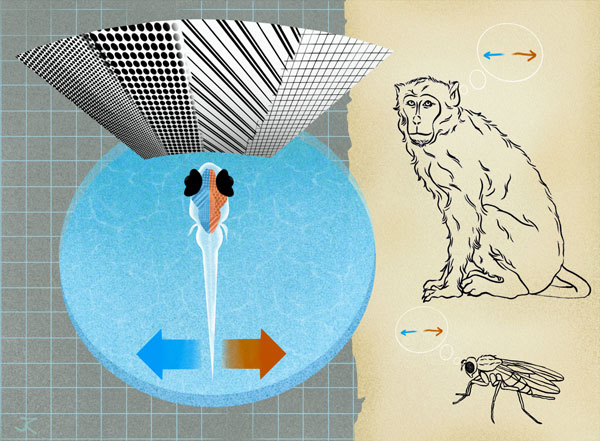Traditional experimental stimuli used to study motion processing in the visual system have consisted of moving gratings and bars. Although these studies have been transformative, it is obvious that the world in which we live is visually highly complex. In particular, the environment has certain statistics that can be used by brains to perform computations more accurately and efficiently. If the world around us is all red, why would our brain want to process the color blue? In fact, asymmetries such as this do exist: the statistics of the natural world are not light/dark symmetric: when looking at a photograph and its negative, we often realize that the negative looks strange or unusual.

Figure: In a complex visual world, animals with very different brains react similarly to specific stimuli – revealing similar processing of motion. Image: Julia Kuhl , MPI of Neurobiology.
This study, published by the Portugues lab, shows that larval zebrafish, a relatively simple vertebrate model organism, are able to perceive motion in a complex family of stimuli called gliders. Gliders are stimuli that have been designed to probe the light/dark asymmetries that exist in the natural world. These stimuli do not move in the usual way that we understand coherent movement, but they contain certain characteristics that natural moving scenes contain. The study shows that the brain of zebrafish is able to use these to improve how they estimate motion. A remarkable result is that when a particular stimulus is shown, fish perceive it as moving one way, but when the stimulus is inverted and black and white are switched, fish perceive it as moving in the opposite way.
The motion percept that these stimuli evoke in zebrafish is in fact very similar to the percept that they evoke in flies and humans. This is remarkable, as the visual systems of these species are very different. However, they are all anchored in the real natural world, and as such, evolution has found different solutions to extract similar information. This provides us with a wonderful opportunity in comparative neuroscience to study how different brain circuits perform similar computations and how slightly different behavioral constraints and demands may have biased these computations. The study shows in fact that the computation of this motion percept already occurs in larval zebrafish at the level of the retina, while it is believed that in primates, motion is at least recomputed in the cortex. This is an intriguing finding that definitely deserves a closer look.
Larval zebrafish provide neuroscientists with the possibility to perform powerful functional imaging experiments where the activity of almost all 100,000 neurons is monitored in vivo. Interestingly, the study shows that the representation of these complex glider stimuli in the brain is arranged in a way that closely aligns to the behavior that they elicit, and not to other spatiotemporal features of the stimulus. This highlights the fact that stimuli are only important because of the behavior that they generate, and gives rise to important questions about the assembly of such circuits and how they may be modulated by processes such as attention and learning.


































